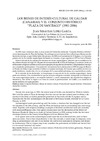Please use this identifier to cite or link to this item:
https://accedacris.ulpgc.es/jspui/handle/10553/2466
| Title: | Los bienes de interés cultural de Gáldar (Canarias) y el conjunto histórico Plaza de Santiago (1981-2006) | Other Titles: | The Assets Of Cultural Interest Of Galdar (Canarias) And The Historical Site "Plaza De Santiago" (1981-2006) | Authors: | López García, Juan Sebastián | Keywords: | Geografía Publicaciones periódicas Historia Humanidades |
Issue Date: | 2006 | Journal: | Vegueta: Anuario de la Facultad de Geografía e Historia | Abstract: | En 1981, hace veinticinco años, la zona central de Gáldar fue declarada “Conjunto Histórico Artístico” con la denominación de Plaza de Santiago. Sin embargo, no era el primer bien cultural que obtenía una distinción de este tipo, ya que Gáldar había sido pionera en 1949 con el yacimiento de El Agujero y La Guancha, primero de los de carácter arqueológico declarado en Canarias, al que seguiría en 1972 la Cueva Pintada
Hasta la década de los setenta prevalecieron los bienes arqueológicos, situación que se modificó en las dos últimas décadas del siglo XX después del reconocimiento de la Plaza de Santiago y su entorno. Junto con edificaciones religiosas también se incluyeron ejemplos de arquitectura doméstica, completándose con algunos yacimientos prehispánicos. Una particular circunstancia fue la declaración en 1993 del pago de Barranco Hondo de Abajo, lo que convertía a Gáldar en el primer municipio de Canarias que contaba con dos conjuntos históricos, siendo éste a la vez el primero de la comunidad autonóma con características rurales.
De la relación de los declarados, si exceptuamos la mayoría de los de carácter arqueológico, buena parte son urbanos. Una característica es que se incluyen categorías variadas, incluyendo la existencia de una zona arqueológica junto a un conjunto histórico y varios monumentos (de arquitectura religiosa y doméstica). Este hecho es lógico si se tiene en cuenta la particularidad de Gáldar y su condición de núcleo histórico de superposición. Twenty five years ago, in 1981, the central zone of Galdar was declared an "Historic Artistic Site" with the name of Plaza de Santiago. But this was not the first cultural asset to obtain a distinction of this kind, as Galdar pioneered protection of this kind with the El Agujero and La Guancha site, the first archaeological site declared in the Canary Islands, followed by La Cueva Pintada, in 1972.Archaeological assets prevailed up until the sixties, a situation that has changed over the last two decades of the 20th century, after the Plaza de Santiago and its surrounding area were recognised. Together with religious buildings, examples of domestic architecture were also included, with some pre-Hispanic sites. One special circumstance was the declaration of the district of Barranco Hondo de Abajo as an Asset of Cultural Interest in 1993, making Galdar the first rural municipal district in the Canary Island Region with two Historic Sites.If we ignore most of the archaeological assets from the list of declared sites, most of these areas are urban. One of their characteristics is that they include a varied range of categories, including an archaeological area next to an historic site and several monuments (religious and domestic architecture). This is a logical step if one considers the particularity of Galdar and the fact that it is an overall historical city centre. |
URI: | https://accedacris.ulpgc.es/handle/10553/2466 | ISSN: | 1133-598X | Source: | Vegueta [ISSN 1133-598X], n. 9, p. 129-146 |
| Appears in Collections: | Artículos Vegueta. n. 09, 2005-2007 |
Page view(s)
244
checked on Dec 21, 2024
Download(s)
331
checked on Dec 21, 2024
Google ScholarTM
Check
Share
Export metadata
Items in accedaCRIS are protected by copyright, with all rights reserved, unless otherwise indicated.
